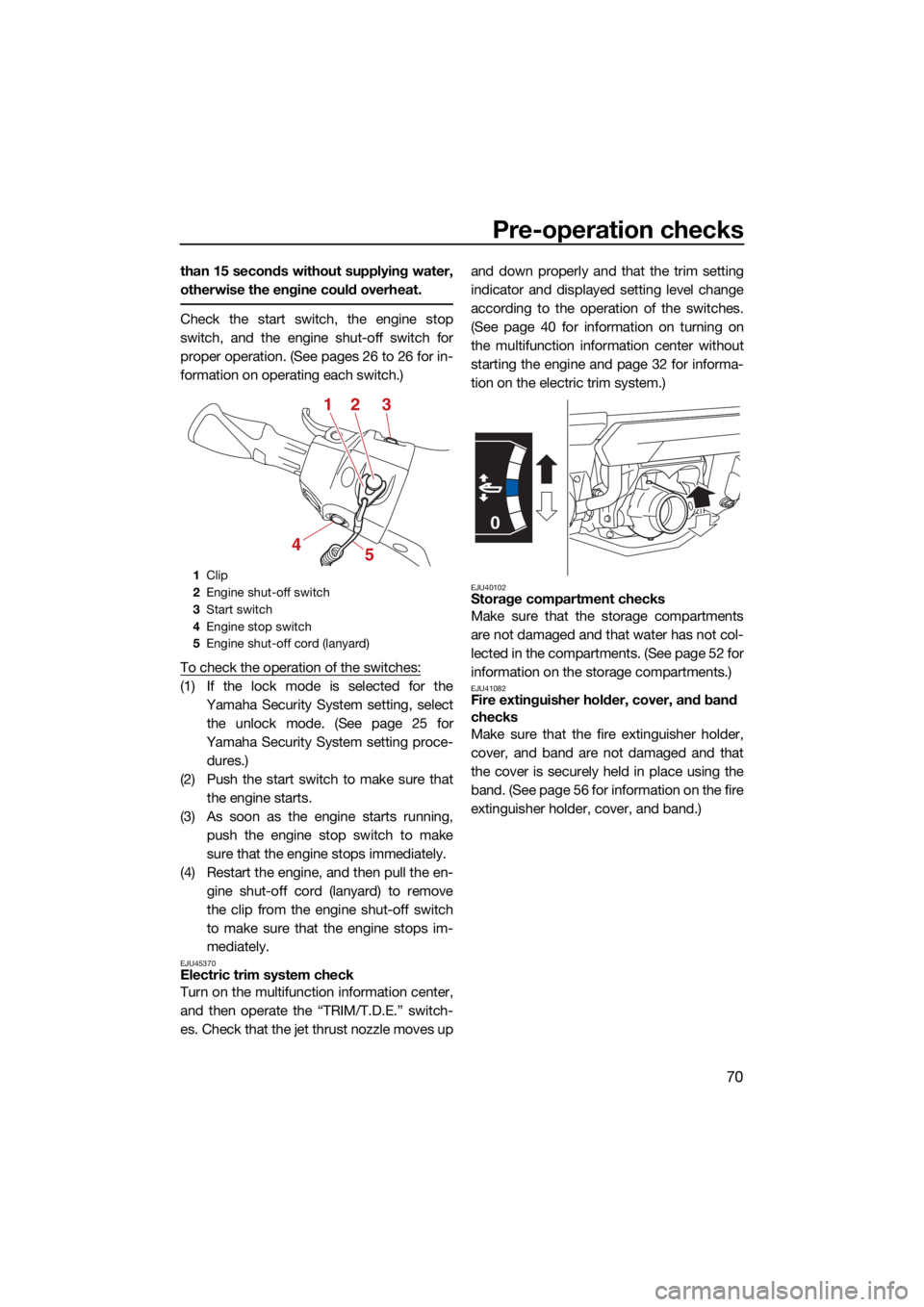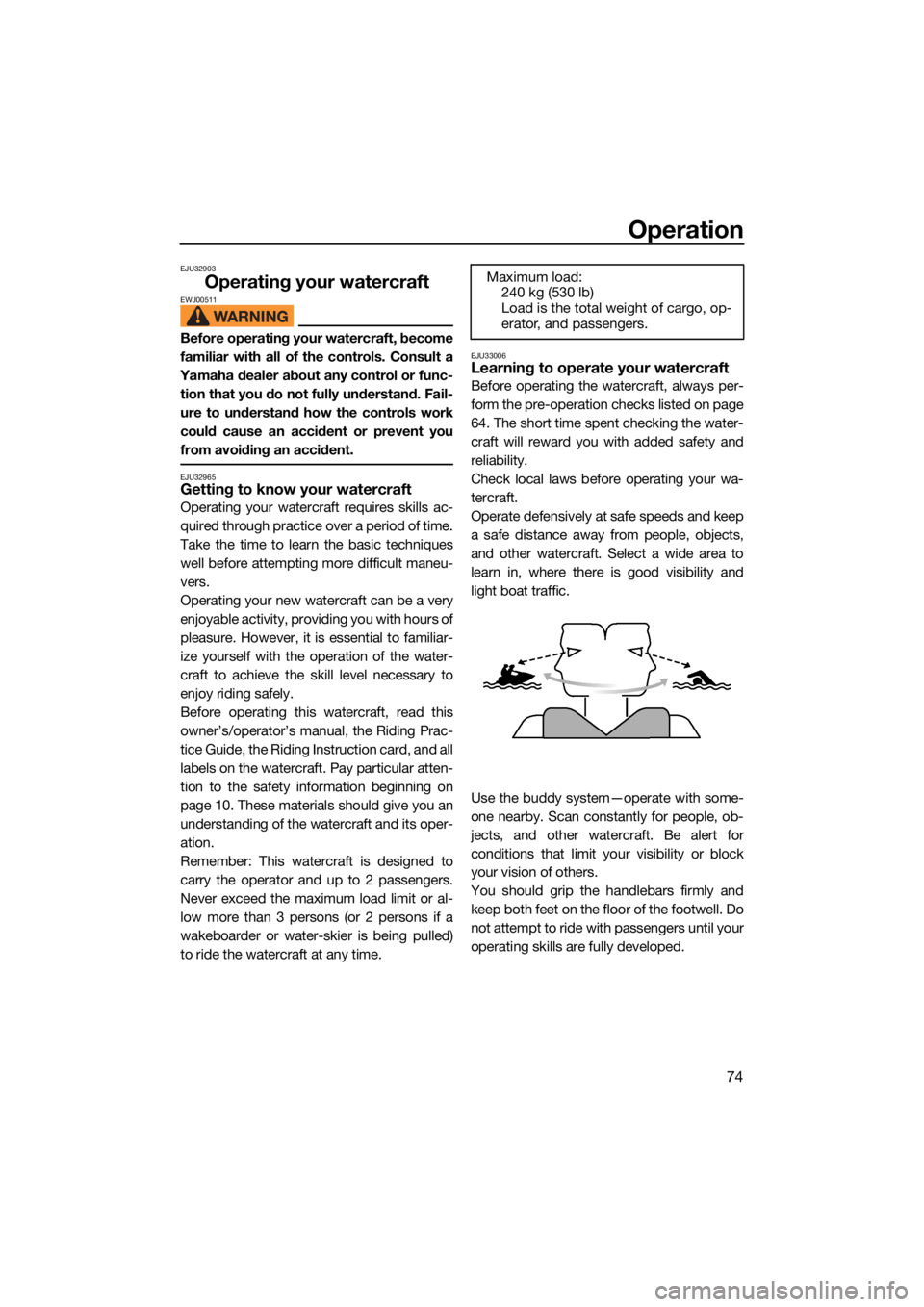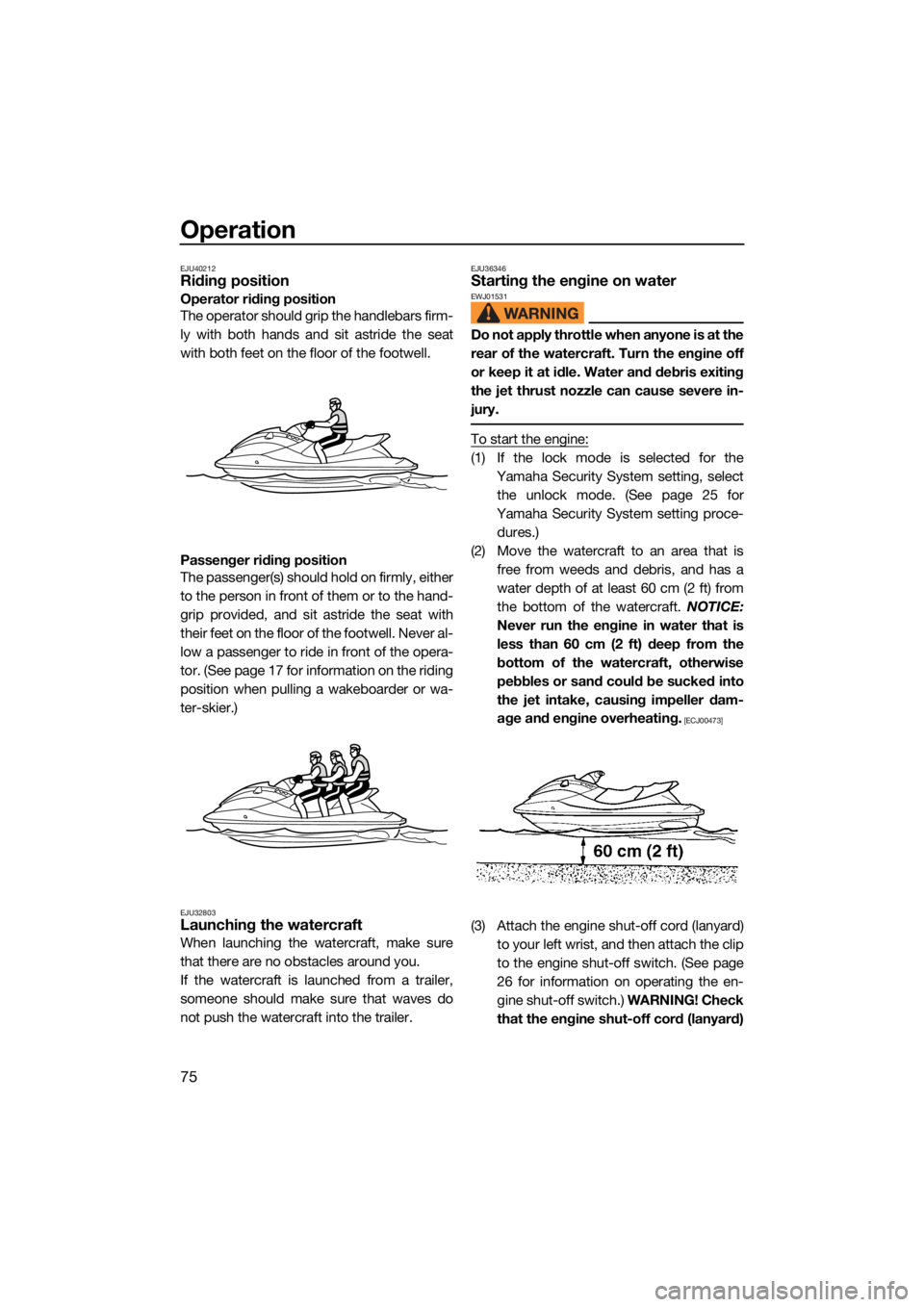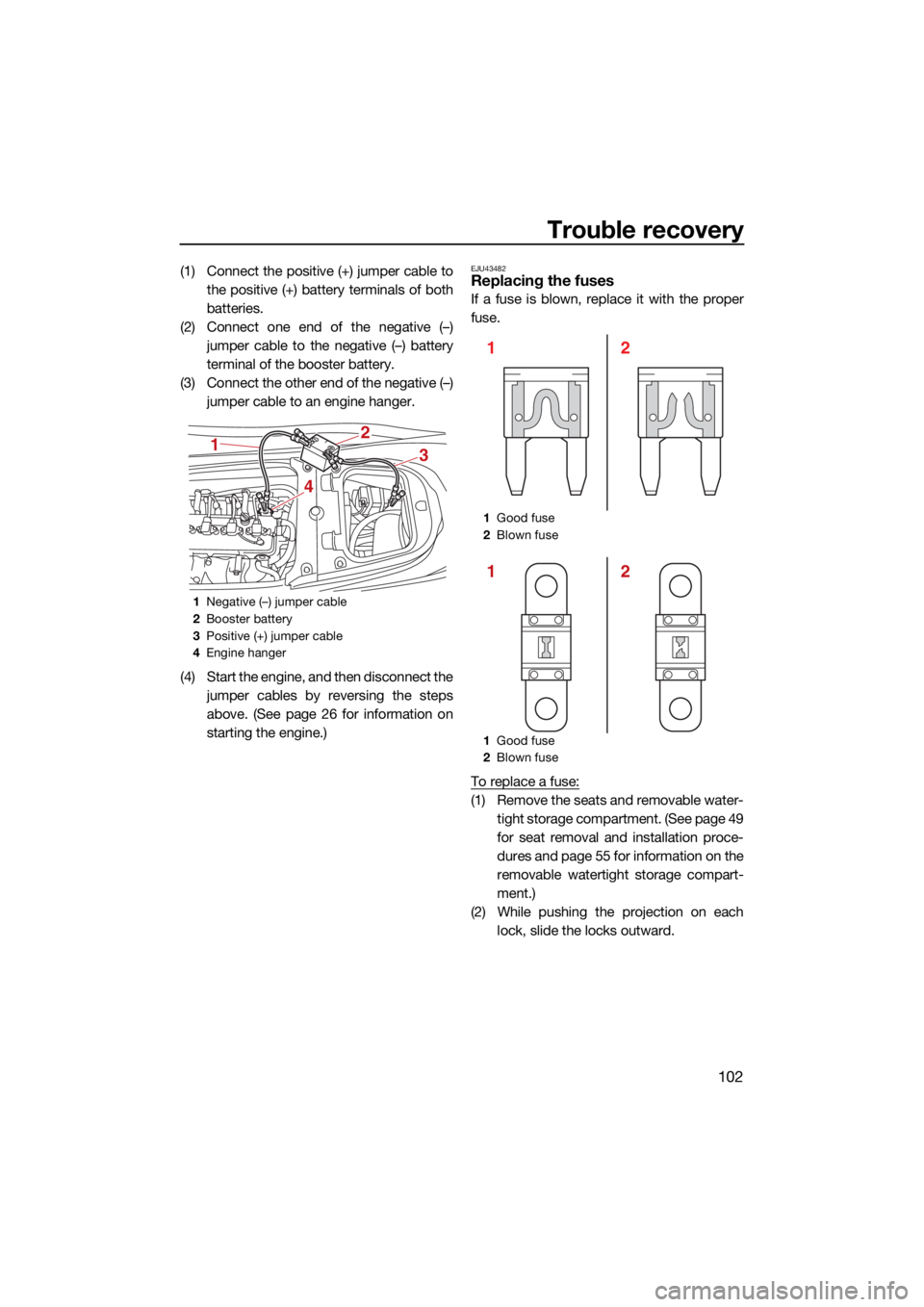2021 YAMAHA FX SVHO lock
[x] Cancel search: lockPage 77 of 116

Pre-operation checks
70
than 15 seconds without supplying water,
otherwise the engine could overheat.
Check the start switch, the engine stop
switch, and the engine shut-off switch for
proper operation. (See pages 26 to 26 for in-
formation on operating each switch.)
To check the operation of the switches:
(1) If the lock mode is selected for theYamaha Security System setting, selectthe unlock mode. (See page 25 for
Yamaha Security System setting proce- dures.)
(2) Push the start switch to make sure that the engine starts.
(3) As soon as the engine starts running, push the engine stop switch to make
sure that the engine stops immediately.
(4) Restart the engine, and then pull the en- gine shut-off cord (lanyard) to remove
the clip from the engine shut-off switch
to make sure that the engine stops im-
mediately.
EJU45370Electric trim system check
Turn on the multifunction information center,
and then operate the “TRIM/T.D.E.” switch-
es. Check that the jet thrust nozzle moves up and down properly and
that the trim setting
indicator and displayed setting level change
according to the operation of the switches.
(See page 40 for information on turning on
the multifunction information center without
starting the engine and page 32 for informa-
tion on the electric trim system.)
EJU40102Storage compartment checks
Make sure that the storage compartments
are not damaged and that water has not col-
lected in the compartments. (See page 52 for
information on the storage compartments.)
EJU41082Fire extinguisher holder, cover, and band
checks
Make sure that the fire extinguisher holder,
cover, and band are not damaged and that
the cover is securely held in place using the
band. (See page 56 for information on the fire
extinguisher holder, cover, and band.)
1 Clip
2 Engine shut-off switch
3 Start switch
4 Engine stop switch
5 Engine shut-off cord (lanyard)
12 3
5
4
0
UF3X72E0.book Page 70 Friday, May 29, 2020 10:09 AM
Page 81 of 116

Operation
74
EJU32903
Operating your watercraftEWJ00511
Before operating your watercraft, become
familiar with all of the controls. Consult a
Yamaha dealer about any control or func- tion that you do not fully understand. Fail-
ure to understand how the controls work
could cause an accident or prevent you
from avoiding an accident.
EJU32965Getting to know your watercraft
Operating your watercraft requires skills ac-
quired through practice over a period of time.
Take the time to learn the basic techniques
well before attempting more difficult maneu-
vers.
Operating your new watercraft can be a very
enjoyable activity, providing you with hours of
pleasure. However, it is essential to familiar-
ize yourself with the operation of the water-
craft to achieve the skill level necessary to
enjoy riding safely.
Before operating this watercraft, read this
owner’s/operator’s manual, the Riding Prac-
tice Guide, the Riding Instruction card, and all
labels on the watercraft. Pay particular atten-
tion to the safety information beginning on
page 10. These materials should give you an
understanding of the watercraft and its oper-
ation.
Remember: This watercraft is designed to
carry the operator and up to 2 passengers.
Never exceed the maximum load limit or al-
low more than 3 persons (or 2 persons if a
wakeboarder or water-skier is being pulled)
to ride the watercraft at any time.
EJU33006Learning to operate your watercraft
Before operating the watercraft, always per-
form the pre-operation checks listed on page
64. The short time spent checking the water-
craft will reward you with added safety and
reliability.
Check local laws before operating your wa-
tercraft.
Operate defensively at safe speeds and keep
a safe distance away from people, objects,
and other watercraft. Select a wide area to
learn in, where there is good visibility and
light boat traffic.
Use the buddy system—operate with some-
one nearby. Scan constantly for people, ob-
jects, and other watercraft. Be alert for
conditions that limit your visibility or block
your vision of others.
You should grip the handlebars firmly and
keep both feet on the floor of the footwell. Do
not attempt to ride with passengers until your
operating skills are fully developed. Maximum load:
240 kg (530 lb)
Load is the total weight of cargo, op-
erator, and passengers.
UF3X72E0.book Page 74 Friday, May 29, 2020 10:09 AM
Page 82 of 116

Operation
75
EJU40212Riding position
Operator riding position
The operator should grip the handlebars firm-
ly with both hands and sit astride the seat
with both feet on the floor of the footwell.
Passenger riding position
The passenger(s) should hold on firmly, either
to the person in front of them or to the hand-
grip provided, and sit astride the seat with
their feet on the floor of the footwell. Never al-
low a passenger to ride in front of the opera-
tor. (See page 17 for information on the riding
position when pulling a wakeboarder or wa-
ter-skier.)
EJU32803Launching the watercraft
When launching the watercraft, make sure
that there are no obstacles around you.
If the watercraft is launched from a trailer,
someone should make sure that waves do
not push the watercraft into the trailer.
EJU36346Starting the engine on waterEWJ01531
Do not apply throttle when anyone is at the
rear of the watercraft. Turn the engine off
or keep it at idle. Water and debris exiting
the jet thrust nozzle can cause severe in-
jury.
To start the engine:
(1) If the lock mode is selected for theYamaha Security System setting, selectthe unlock mode. (See page 25 for
Yamaha Security System setting proce- dures.)
(2) Move the watercraft to an area that is free from weeds and debris, and has a
water depth of at least 60 cm (2 ft) from
the bottom of the watercraft. NOTICE:
Never run the engine in water that is
less than 60 cm (2 ft) deep from the
bottom of the watercraft, otherwise
pebbles or sand could be sucked into
the jet intake, causing impeller dam-
age and engine overheating.
[ECJ00473]
(3) Attach the engine shut-off cord (lanyard) to your left wrist, and then attach the clip
to the engine shut-off switch. (See page
26 for information on operating the en-
gine shut-off switch.) WARNING! Check
that the engine shut-off cord (lanyard)
UF3X72E0.book Page 75 Friday, May 29, 2020 10:09 AM
Page 89 of 116

Operation
82
(4) Have the first passenger board using thesame procedure as the operator, place
their feet on the floor of the footwell, and
securely hold on to the operator.
(5) Have the second passenger follow the same procedure. When the second pas-
senger is boarding, try to balance the
watercraft together with the first passen-
ger.
(6) Make sure that the passenger(s) have their feet on the floor of the footwell and are securely holding on to the person in
front of them or to the handgrip provided.
(7) Attach the engine shut-off cord (lanyard) to your left wrist, and then attach the clip
to the engine shut-off switch.
(8) Look in all directions, start the engine, and then start off slowly.
EJU33084Starting offEWJ00713
To avoid collisions:
Scan constantly for people, objects, and
other watercraft. Be alert for conditions
that limit your visibility or block your vi-
sion of others.
Operate defensively at safe speeds and
keep a safe distance away from people,
objects, and other watercraft.
Do not follow directly behind watercraft
or other boats. Do not go near others to
spray or splash them with water, go too
close to other boats, or go too fast for
the traffic conditions. Avoid sharp turns
or other maneuvers that make it hard for
others to avoid you or understand where
you are going. Avoid areas with sub-
merged objects or shallow water.
Take early action to avoid collisions. Re-
member, watercraft and other boats do
not have brakes. Do not release the
throttle lever when trying to steer away
UF3X72E0.book Page 82 Friday, May 29, 2020 10:09 AM
Page 103 of 116

Specifications
96
EJU45442
Specifications
Watercraft capacity:
Maximum people on board:3 person
Maximum load capacity: 240 kg (530 lb)
Dimensions and weight:
Length:
3.58 m (140.9 in)
Width: 1.27 m (50.0 in)
Height: 1.23 m (48.4 in)
Dry weight: 371 kg (818 lb) (FX SVHO)
372 kg (820 lb) (FX CRUISER SVHO)
373 kg (822 lb) (FX LIMITED SVHO)
Performance:
Maximum output (according to ISO 8665/SAE
J1228):183.9 kW at 7500 r/min
Maximum fuel consumption: 80.7 L/h (21.3 US gal/h, 17.8 Imp.gal/h)
Cruising range at full throttle:
0.87 hour
Trolling speed: 1250 ±100 r/min
Engine:
Engine type:
Liquid cooled 4-stroke, DOHC
Number of cylinders: 4
Engine displacement: 1812 cm³
Bore × stroke:
86.0 × 78.0 mm (3.39 × 3.07 in)
Compression ratio: 8.5 : 1
Valve clearance-intake (cold): 0.14–0.23 mm (0.0055–0.0091 in)
Valve clearance-exhaust (cold):
0.36–0.45 mm (0.0142–0.0177 in)
Lubrication system: Wet sump
Cooling system: Water
Starting system:
Electric Ignition system:
T.C.I.
Spark plug (NGK): LFR7A
Spark plug gap:
0.8–0.9 mm (0.031–0.035 in)
Battery capacity: 12 V, 18 Ah
Battery type: YTX20L-BS
Charging system:
Flywheel magneto
Drive unit:
Propulsion system:Jet pump
Jet pump type: Axial flow, single stage
Impeller rotation:
Counterclockwise
Jet thrust nozzle angle: 24+24 °
Jet thrust nozzle trim angle: -5, -3, 0, 3, 6 °
Fuel and oil:
Recommended fuel:Premium unleaded gasoline
Minimum octane rating (PON): 91
Minimum octane rating (RON):
95
Recommended engine oil: YAMALUBE 4W or 4-stroke motor oil
Recommended engine oil type SAE: SAE 10W-30, 10W-40, 20W-40, 20W-50
Recommended engine oil grade API:
API SG, SH, SJ, SL
Fuel tank total capacity: 70 L (18.5 US gal, 15.4 Imp.gal)
Engine oil quantity with oil filter replacement: 3.7 L (3.91 US qt, 3.26 Imp.qt)
Engine oil quantity without oil filter replacement:
3.5 L (3.70 US qt, 3.08 Imp.qt)
Engine oil total quantity: 5.3 L (5.60 US qt, 4.66 Imp.qt)
UF3X72E0.book Page 96 Friday, May 29, 2020 10:09 AM
Page 104 of 116

Trouble recovery
97
EJU34562
Troubleshooting
If you have any trouble with your watercraft, use the troubleshooting chart to check for the
possible cause.
If you cannot find the cause, consult a Yamaha dealer.
EJU45280Troubleshooting chart
Confirm the possible cause and remedy, and then refer to the applicable page.
TROUBLEPOSSIBLE CAUSE REMEDYPAGE
Engine does not
start (Starter motor
does not turn over) Ya m a h a S e -
curity System
Lock mode selected Select unlock mode
25
Engine shut-
off switch Clip not in place Install clip
26
Fuse Burned out Replace fuse and
check wiring 102
Battery Run down Recharge87
Poor terminal con-
nections Tighten as required
87
Terminal corroded Clean or replace 87
Starter motor Faulty Have serviced by
Yamaha dealer —
Engine does not
start (Starter motor
turns over) Throttle lever Squeezed
Release26
Faulty Have serviced by
Yamaha dealer —
RiDE lever Squeezed Release26
Faulty Have serviced by
Yamaha dealer —
Fuel Fuel tank empty Refill as soon as pos-
sible 57
Stale or contaminat-
ed Have serviced by
Yamaha dealer
—
Fuel tank Water or dirt present Have serviced by Yamaha dealer—
Spark plug Fouled or defective Have serviced by Yamaha dealer—
Fuel injec-
tion system Fuel pump faulty Have serviced by
Yamaha dealer —
UF3X72E0.book Page 97 Friday, May 29, 2020 10:09 AM
Page 109 of 116

Trouble recovery
102
(1) Connect the positive (+) jumper cable tothe positive (+) battery terminals of both
batteries.
(2) Connect one end of the negative (–) jumper cable to the negative (–) battery
terminal of the booster battery.
(3) Connect the other end of the negative (–) jumper cable to an engine hanger.
(4) Start the engine, and then disconnect the jumper cables by reversing the steps
above. (See page 26 for information on
starting the engine.)EJU43482Replacing the fuses
If a fuse is blown, replace it with the proper
fuse.
To replace a fuse:
(1) Remove the seats and removable water-tight storage compartment. (See page 49
for seat removal and installation proce-
dures and page 55 for information on the
removable watertight storage compart-
ment.)
(2) While pushing the projection on each lock, slide the locks outward.
1Negative (–) jumper cable
2 Booster battery
3 Positive (+) jumper cable
4 Engine hanger
1
4
3
2
1Good fuse
2 Blown fuse
1 Good fuse
2 Blown fuse
2
1
2
1
UF3X72E0.book Page 102 Friday, May 29, 2020 10:09 AM
Page 110 of 116

Trouble recovery
103
(3) Remove the electrical box cover.
(4) While pushing both sides of the fuse boxcover inward, pull the cover toward the
bow and remove it.
(5) When replacing the SCU fuse, remove the screws, and then remove the fuse. Install the spare fuse, and then tighten
the screws.
(6) When replacing a fuse other than the SCU fuse, remove the fuse using the
fuse puller. Install a spare fuse of the
proper amperage. WARNING! Do not
use fuses of a different amperage than
recommended. Substitution with a
fuse that has an improper rating can
cause extensive electrical system
damage and possible fire.
[EWJ00803]
1 Electrical box cover
2 Lock
3 Projection
1 Fuse box cover
2
3
2
3
1
1
1Electronic throttle valve fuse
2 Fuel pump fuse
3 Main relay drive fuse
4 Main fuse
5 Spare fuse
6 Fuse puller
7 Battery fuse
8 Screw
9 SCU fuse (BCU fuse)
10 Unused fuse
1
5
23 4 5 6 7
8
9
8
10
UF3X72E0.book Page 103 Friday, May 29, 2020 10:09 AM